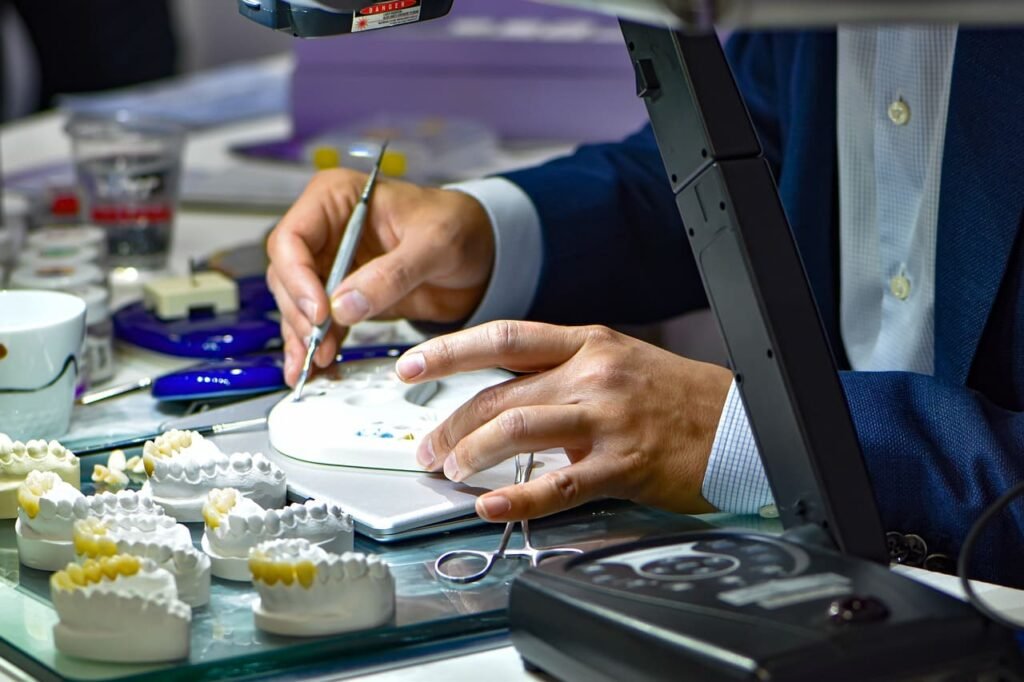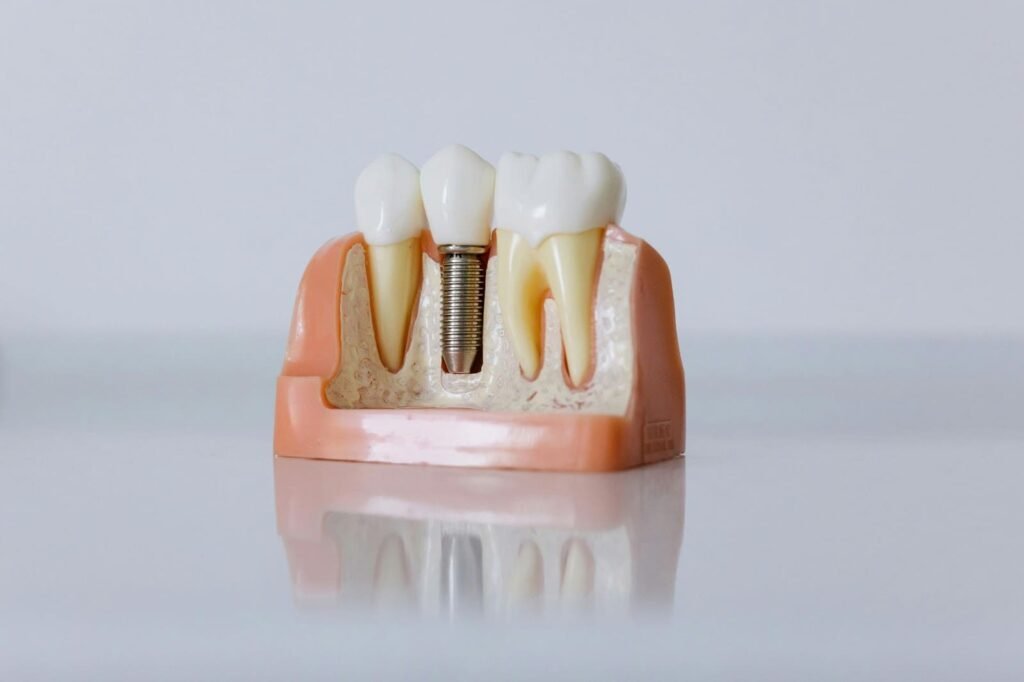Dental 3D printing technology has changed how dental labs operate in modern dentistry by providing better accuracy, speed, and cost savings. This advanced technology helps dental professionals create precise models, dentures, and tools that fit each patient perfectly. Unlike older methods, which take a lot of time and can have mistakes, 3D printers for dental labs make the process faster and more reliable.
The importance of 3D printing in dental labs comes from its ability to quickly and affordably create custom solutions, improving patient care. In this article, you will learn the basics of 3D printing for dental labs and its benefits. We will also cover the most popular uses, tips for choosing the right printer, and what changes and improvements are expected in the future.

What is a 3D Printer for Dental Labs?

A 3D printer for dental labs is a specialized device that creates three-dimensional dental models, prosthetics, and appliances by layering materials based on digital designs. Compared to conventional techniques, which require much manual work and may be applied inaccurately, 3D printers provide a more efficient solution.
Types of 3D Printers Used in Dental Labs
Understanding what kinds of printers exist is crucial for comprehending 3D printing in dental laboratories. All the different types have advantages and are keyed In the different dental applications.
- Stereolithography (SLA): SLA with high image resolution uses ultraviolet lasers to cure the part and works well for detailed dental models.
- Digital Light Processing (DLP): DLP printers are substantially faster than SLA. It is almost identical to SLA in that it uses projection to shine rather than drawing outlines, which increases the apparatus’s speed significantly.
- Selective Laser Sintering (SLS): SLS is the most durable way of reconstructing dental modules. This technique involves the use of lasers to melt powdered material and form it into blocks.
- Fused Deposition Modeling (FDM): FDM is more affordable to use than basic models or prototypes; however, it is not widely used in dental labs.
Materials Used in Dental 3D Printing Technology
The use of 3D printers for dental labs is thus strongly backed by the raw materials used in the process. Dental material is diverse and provides various characteristics to meet human requirements.
- Resins: Resins are used in carving crowns, bridges, and dental models because of their preciseness and high surface finish.
- Metals: Ideal for frameworks, custom-made implants, and partial denture appliances.
- Ceramics: Suitable for cosmetic purposes, such as veneer.
Advantages of having 3D printers in Dental Laboratories
There are numerous technical advantages to choosing 3D printing in dental labs, and it also defines the advantages literally. They include the enhanced precision of operations, fewer costs to the dentist, and many other aspects which are revolutionizing dental practices.
1. Improved Precision and Accuracy
These assets have a closer and more accurate quality to the creator’s vision, thereby giving a better performance than the Silver series. This is due to dental 3D printing technology, which offers high accuracy in the development of dental prosthetics as well as aligners and models that perfectly fit in the dental arch. This reduces the chances of making mistakes as patient results improve.
2. Time-Saving Advantages
These conventional techniques might even take days or even weeks, but in dental 3D printing technology the manufacturing time is reduced incredibly. Tasks are produced within hours; ranging from making dental models to making prosthetics.
3. Cost-Effectiveness
3D printers for dental labs lower overall expenses by reducing material waste and labor costs. Dental labs can produce high-quality products at a fraction of the cost of traditional methods.
4. Customization and Patient-Specific Solutions
This dental 3D printing technology also helps in the manufacturing of more comfortable individual dental implants, crowns and orthodontic appliances or instrumentations.
5. Streamlined Workflow
Combining dental 3D printing technology with digital scanning makes them even easier. Especially for specialists, it becomes possible to transfer into metal or ceramic restorations directly from digital impressions, thereby reducing mistakes and time spent on other tasks.
Common Applications of 3D Printers in Dental Labs
The versatility of the 3D printers for dental labs has presented a number of opportunities for application in various dental labs. The following issues show that dental 3D printing technology is revolutionizing the functionality of dental specialists in practice.
1. Dental Models
Dental 3D printing has the advantage of providing high accuracy on the diagnostic models, which will benefit treatment planning as well as the education of those involved. They become useful in explaining difficult scenarios and enhancing interaction between the dentist and the user.
2. Crowns and Bridges

Advanced crown and bridge fabrication using high-definition dental 3D printing technology ensures that the prosthesis is both strong and accurately fitted with the patient’s natural teeth shade. This makes it faster to restore any damage that has been done, hence making it appropriate for both the dentists and the patient.
3. Orthodontic Appliances
Invisible aligners and retainers can be manufactured in large quantities with equality through three-dimensional printing. The use of dental 3D printing technology is fast in making the adjustments that make the orthodontic treatment more efficient and less painful.
4. Surgical Guides
Implant placement surgery uses Dental Surgical Guide created via dental lab 3D printing, which decreases risks and enhances outcomes. The multipurpose guides serve to obtain the ‘right’ positioning and orientation throughout the operations.
5. Custom Implants and Dentures

This type of tissue engineering allows for customized implants and dentures based on an individual patient’s need. Such levels of customization benefit from improved patient satisfaction and oral health.
6. Prototyping and Testing
Dental labs also employ the use of dental 3D printing technology in the process to facilitate short-run product development where other new designs and new technologies are to be tested before being manufactured for the whole market. This generates new and enhanced designs on products, thus enhancing the product in the market offered.
Best 3D Printer for Dentistry Labs in the year 2025
These brands are recognized for producing high-quality 3D printers for dental labs, offering precision, reliability, and efficiency for various dental applications. Their printers ensure accurate results with specialized materials for custom dental products.
- Aidite 3D Printer: Aidite 3D Printers offer advanced features for dental labs, focusing on precision and ease of use. They are well known for providing great print output in terms of quality and also reducing the time expected for printing, which is great for producing elaborate dental work.
- Formlabs: Formlabs provides accessible high-quality 3D Printers incorporating stereolitography – a type of printing that solidifies the liquid resin with a laser. The Form 3B+ is designed for dental labs centered, however it can also print top dental items like models, guides, as well as crowns. It’s easy to use, reliable, and works with materials for dental applications, making it a popular choice for dental labs.
- Asiga: Asiga is known for making very precise and flexible 3D printers. They use DLP (another type of 3D printing where light is used to harden resin). Asiga printers can create detailed dental items like crowns and dentures and use many different types of dental materials. This flexibility and precision make Asiga a great choice for labs needing high-quality, detailed prints.
- EnvisionTEC: EnvisionTEC’s printers use a fast DLP printing method that quickly creates accurate prints. They are great for making detailed dental items, like implants and crowns. The speed and high accuracy of EnvisionTEC printers help dental labs create high-quality work quickly, which is why they are a popular choice.
These brands are chosen for their durability, versatility, state of the art technology and ability to work with dental materials making it easier for dental labs to use when it comes to 3D printing.
The Future of 3D Printing in Dental Labs
The future of 3D printing for dental labs is bright and will look even brighter as various advancements are underway.
– New Material and Printer Technology
New materials with enhanced properties are emerging, expanding what 3D printing for dental labs can do in dentistry. Printer technologies are also becoming faster and more precise.
– Integration with AI and Digital Dentistry
Artificial intelligence is revolutionizing 3D printing for dental labs by automating design processes and optimizing workflows. AI-driven solutions enhance accuracy and reduce production time.
– Fully Automated Workflows
It is possible that in the future, the workflow of the dental labs will include all automation processes, from digital impression-taking to the final products. This cuts down on human over typical tasks, thus enhancing productivity and quality.
– Trends in Accessibility and Affordability
As dental 3D printing technology becomes more accessible, smaller dental labs can adopt it without significant financial strain. This democratization fosters innovation and improves patient care across the board.
FAQs
What is the best 3D printer for dental labs?
The best printer will depend on the needs of the lab. Some of the best ones in the current market are Aidite 3D Printer due to its high accuracy, flexibility, and suitability for a wide range of dental applications.
How much does a dental 3D printer cost?
Dental lab 3D printer prices range from $3,000 to $50,000, depending on the printer’s features and brand.
What materials are used in dental 3D printing?
Common materials include resins for models, metals for frameworks, and ceramics for aesthetic restorations.
How much time will it take to complete a dental model?
The time of a dental model depends on the complexity and size of the item to be printed: it can take 1-3 hours to print a model using a printer.
Can providers and patients rely on practical 3D-printed dental products?
Of course, 3D-printed dental products are as safe and strong as conventional implants: people can confidently expect to receive long-lasting and functional restorations.
Conclusion
The adaptability of 3D printing across the dental industry has revolutionized dental labs by displacing precision, efficiency, and cost advantages. Some of the uses that are most closely related to 3D printing are to create dental models and to create custom prosthetics. Identification of suitable 3D printers is useful in meeting the requirements of the available 3D labs in the market. All in all, the Aidite 3D printer is perfect for dental labs because of the accuracy it brings and flexibility in achieving different dental uses.



